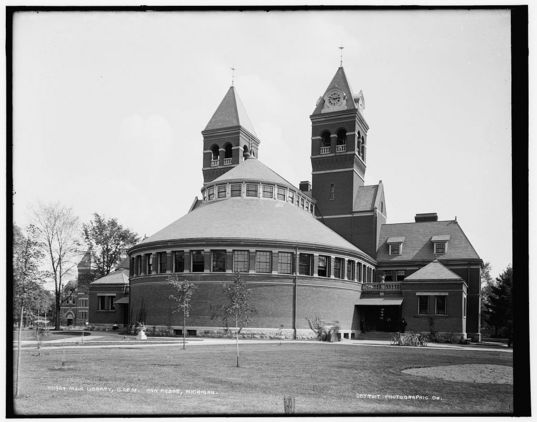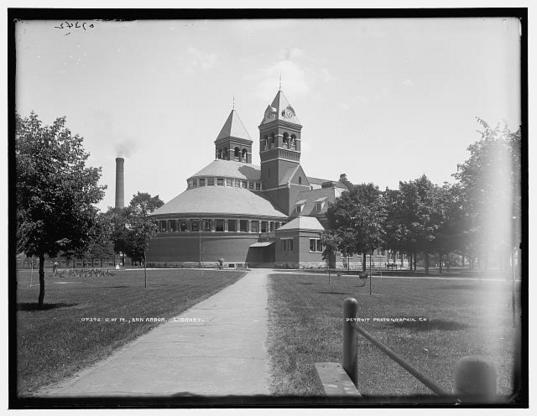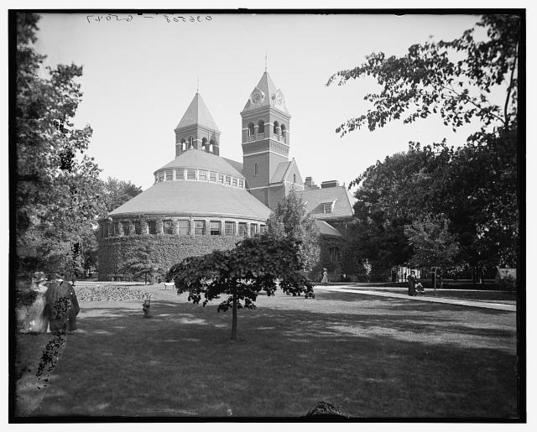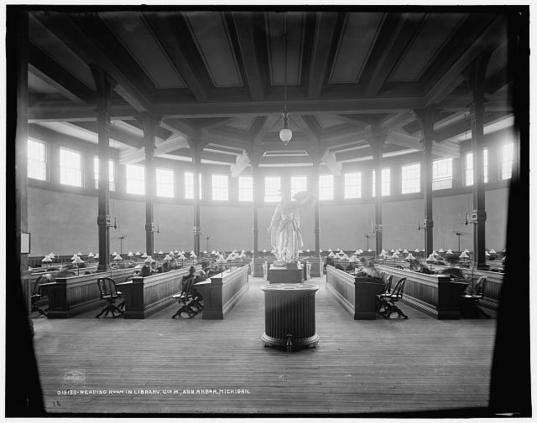All that remains are the stacks from University of Michigan's old General Library

Old U-M General Library, photo taken 1890-1901. Library of Congress, Prints & Photographs Division, Detroit Publishing Co. Collection, [LC-D4-11924].
Recently, I had the pleasure of walking through the old fireproof book stacks in the basement of the Harlan Hatcher Graduate Library. A slice of the past, these stacks are the only part that remains of the old General Library on the campus of the University of Michigan.Â
As you descend the stairs, you are transported back in time to an era where newel posts were beautiful and the banisters evoked the beauty of artisan woodwork, even if they weren’t necessarily hand-hewn and hand-shaped themselves.
The Hatcher Library sits on the south end of the Diag on U-M’s Central Campus, and is built on the site of the old General Library, which stood there from its completion in 1883 to its destruction (minus the original fireproof book stacks) in 1918.

The old General Library from a distance. Library of Congress, Prints & Photographs Division, Detroit Publishing Co. Collection, [LC-D4-7342].
The old General Library was designed by the architectural firm Ware and Van Brunt, and was constructed under James Appleyard, a Lansing resident. At the time of initial construction, the structure cost $100,000 to build. In 1898, more book stacks were added to the library at a cost of $13,450.00; this expansion gave the library holding space for 200,000 volumes.

The rounded wall of the reading room at U-M's old General Library covered in ivy. Library of Congress, Prints & Photographs Division, Detroit Publishing Co. Collection, [LC-DIG-det-4a18604] & [LC-D4-36508].
One of the distinguishing features of the library was its rounded reading room. Originally intended to be both a library and an exhibit space for art, this building was unique. When the season was right, ivy would cover the curved walls of the reading room, making the structure even more attractive.

An interior view of the rounded reading room in the old General Library on U of M's campus. Library of Congress, Prints & Photographs Division, Detroit Publishing Co. Collection, [LC-DIG-det-4a08608] & [LC-D4-13133].
The reading room originally had swivel chairs and desks that the students could use, though the room use was split according to sex; the men's side and the women's side. The windows on the curved wall brought in natural light, bringing another feature of beauty into the space. The library was largely made of wood. In 1915, there were concerns about the safety of the building, largely because its wood construction made it vulnerable to fire. In 1918, with the exception of the aforementioned fireproof book stacks, the old General Library on U of M’s campus was demolished to make way for the new library.
The Library of Congress page associated with these images can be found here.
Elizabeth Palmer is the Customer Advocate at AnnArbor.com as well as a contributor. She writes about food and food traditions, sustainable development and her experiences as a curvy girl. She has a bachelor’s degree in photography and is finishing her masters in historic preservation. Elizabeth also teaches a course on sustainable development at Eastern Michigan University. You can contact Elizabeth by e-mailing her at elizabethpalmer@annarbor.com.


Comments
Jens Zorn
Tue, Apr 6, 2010 : 10:58 p.m.
Thank you for this evocative, well-illustrated article. For many years it seemed as though a first-class university needed ever larger buildings to house its book collections, hence the construction of the elegant structures we have today. But with the advent of digital storage, it may well be that buildings of the old General Library's size but dispersed over the campus, will be sufficient.